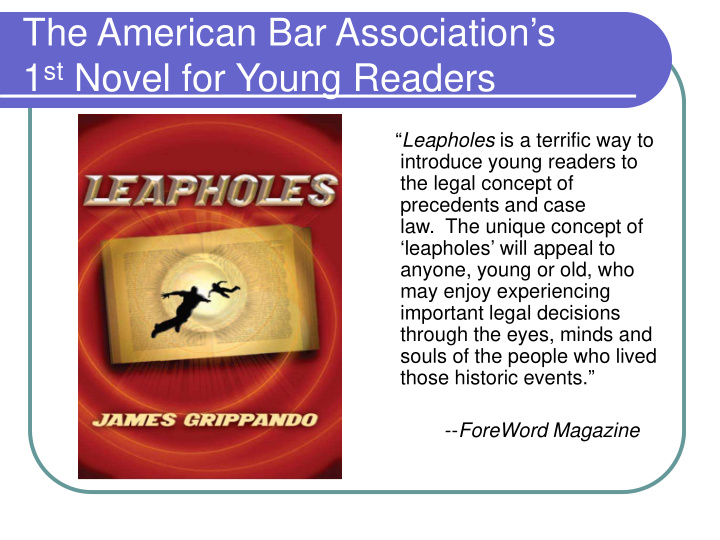



The American Bar Association’s 1 st Novel for Young Readers “ Leapholes is a terrific way to introduce young readers to the legal concept of precedents and case law. The unique concept of ‘leapholes’ will appeal to anyone, young or old, who may enjoy experiencing important legal decisions through the eyes, minds and souls of the people who lived those historic events.” -- ForeWord Magazine
Was Rosa Parks a real Person? Her arrest in 1955 started a bus boycott in Montgomery, Alabama led by Dr. Martin Luther King, Jr. Battles like hers eventually ended up in the U.S. Supreme Court.
“Can We Go There?” To Montgomery Alabama? To the U.S. Supreme Court in Washington D.C.?
“No, I want to Go to 1955.”
Why not? What if loopholes were…
Leapholes: The Cases Every case mentioned in Leapholes is a real case that involved real people who had real problems For some, those cases were a matter of life and death.
Legal Precedent What is “legal precedent?” How are legal precedents created? Should something that happened to real people a long time ago have any impact on how we decide what is right or wrong in today’s society? Why or why not?
United States v. Holmes (1842) Hit iceberg in 1841 and sank in North Atlantic Ocean Lifeboats overloaded Crew threw 12 men and 2 women overboard All would have died if load had not been lightened
Holmes Decision Judge said “sortition should be adopted." The word is derived from the Latin and means “to cast or draw lots.” Holmes was convicted of manslaughter
Holmes : Good or Bad Precedent? Was the judge right in condemning the sailor’s actions? Should the passengers have cast lots to determine who should live and who should die? What would you have done if you had been on that sinking lifeboat?
Leapholes & “Legal Evil” Every suspense novel has “good vs. evil” In Leapholes , “Legal Evil” lives in the worst cases (legal precedents) ever decided by the U.S. Supreme Court One of those decisions was . . .
Dred Scott v. Sandford (1857) Dred Scott, a slave in Missouri, was taken by his owner in 1836 to Illinois & a free portion of the Louisiana Territory. When his owner died, Scott sued for freedom saying that when he was taken to places that outlawed slavery, he had become free.
Dred Scott – Original Petition for Freedom (1846) How do you think Dred Scott must have felt asking a court to decide that another man did not “own” him? How do you think people in Missouri felt about this lawsuit? How much courage do you think it took for Dred Scott to sign his name with an “X” on this document? How dangerous do you think it was for a white lawyer to represent Dred Scott as the country was moving toward Civil War?
Dred Scott: “Legal Realism” The Decision: -- Slaves and their descendants are not citizens & have no right to sue -- Congress has no power to outlaw slavery in territories (Missouri Compromise void) Chief Justice Roger Taney, who wrote the court’s opinion, once owned slaves. Five of the nine justices were from slave states. Did Dred Scott have any real hope of winning?
Prigg v. Pennsylvania (1842) In Leapholes, Legal Evil lives “where the brood follows the dam.” That doctrine was created in ancient times to determine ownership rights over animals such as horses or cattle. If someone owned the mother (the “dam”), they also owned her offspring (the “brood”). In 1842, the U.S. Supreme Court extended that doctrine to human beings. The Court decided that any child born to a slave was also a slave, even if the child was born in a state where slavery was illegal. Was this a proper use of legal precedent? Why or why not?
Leapholes and Equal Rights In Leapholes, Ryan’s lawyer warns that “Legal Evil” is alive and well today. Can you think of any modern-day examples of Legal Evil at work? Why do you think the U.S. Constitution provides “equal protection” under law? Does everyone in today’s society have equal rights under the law?
Leapholes & Confession/self-incrimination In Leapholes, Ryan’s father is in prison because he pleaded guilty to a crime. He tells Ryan, however, that he is innocent. Can you think of any reasons why a person might plead guilty to a crime that he did not commit? Have you ever confessed to something you did not do in order to protect someone else? Can people be forced into a confession? What makes a confession reliable? How can we decide if a confession is reliable? Why do you think the U.S. Constitution protects the right to remain silent?
Recommend
More recommend